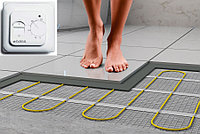Using synthetic biology, this matter would be used to create micro-habitats or systems that would allow humans to explore other planets in the solar system with environments that would otherwise be lethal. Fitted around the neck and over the shoulders, the exterior is made up of pods for algae-based air-purification and biofuel collection to produce and store oxygen. Bacteria contained on the bodice’s swirling textured surface would convert the planet’s hydrocarbons into edible matter. The pieces were unveiled today as part of Stratasys’ collection The Sixth Element: Exploring the Natural Beauty of 3D Printing, which is on display at the EuroMold event in Frankfurt, Germany, until 28 November. This image: ZuhalThe project, titled Wanderers: An Astrobiological Exploration, includes four pieces that are imagined to be embedded with living matter. Positioned around the lower abdomen, the device is proposed to consume and digest biomass, absorb nutrients, generate energy from sucrose accumulating in the side pockets and expel waste. Finally, Al-Qamar is designed as a «wearable biodome». Related story: ACADIA exhibits multi-material 3D-printed designs by Zaha Hadid, Francis Bitonti and more The team used an Objet500 Connex3 Color, Multi-material 3D Production System to 3D print the «skins» in a range of plastics with different densities – each one suited to a different planet in the Earth’s solar system. «With this collection, we have designed spatially and materially complex wearables pointing towards the possibility of containing living matter that can interact with the environment.»
OtaaredThe wearable structures incorporate pockets and tracts that could house the biological material, which would be synthetically adapted to make chemical changes in the surrounding atmosphere. «Each piece intends to hold life-sustaining elements contained within 3D-printed vascular structures with internal cavities,» said Oxman. Zuhal is created to adapt to the vortex storms on Saturn. Neri Oxman and members of the Mediated Matter group at MIT Media Lab – an interdisciplinary research department at the Massachusetts Institute of Technology – collaborated with 3D printing company Stratasys to create structures with varied rigidity, opacity and colour. Main image: Mushtari.
Library builder
Articles about the repair, construction, interior design and landscaping, plumbing, electrical, waterproof wire, wire gas, building materials, construction machinery and equipment ...
Библиотека строительства - статьи о строительстве и ремонте © 2020
Frontier Theme



